Understanding plants' responses to nitrogen and determining an economical application rate will be vital in growers' fertiliser strategies this year, according to Teagasc’s Dr Richie Hackett.
As fertiliser prices remain at eye-wateringly high levels, the first session of this year’s online National Tillage Conference focused on crop nutrition strategies.
Richie explained that a plant's response to nitrogen (N) is not a straight line, but instead is a curve.
He said that the first 50% of an N application typically gives 70% of the crop yield. The higher up in the curve you go, this response decreases and gives you a lower return from applying N.
Example
For example, based on typical prices over the past few years of grain (€154/t) and CAN (€250/t), 1kg N/ha would return around 30kg of grain on the lower end of the curve.
However, as N application rates increase and we move up the response curve, this return decreases until it reaches the point where no additional grain is returned from spreading additional nitrogen.
Based on the above prices, a breakeven N rate of 209kg N/ha is calculated.
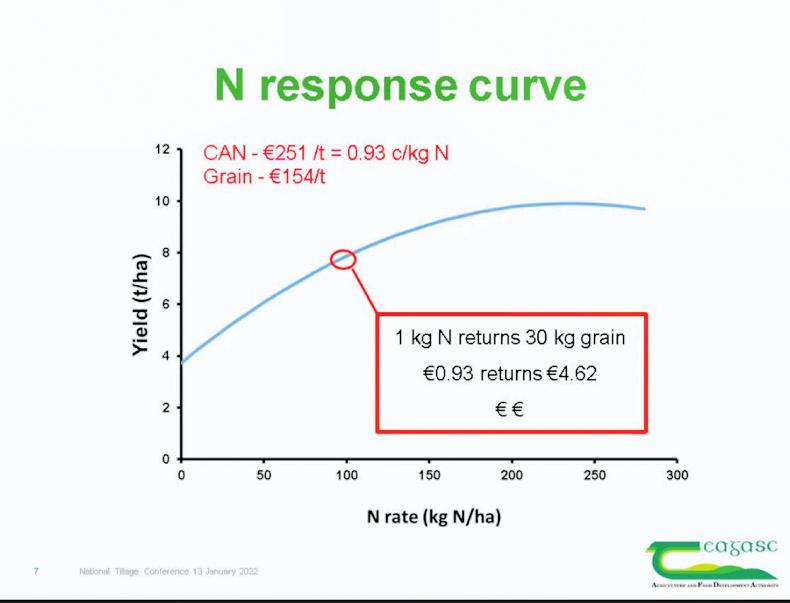
High N response
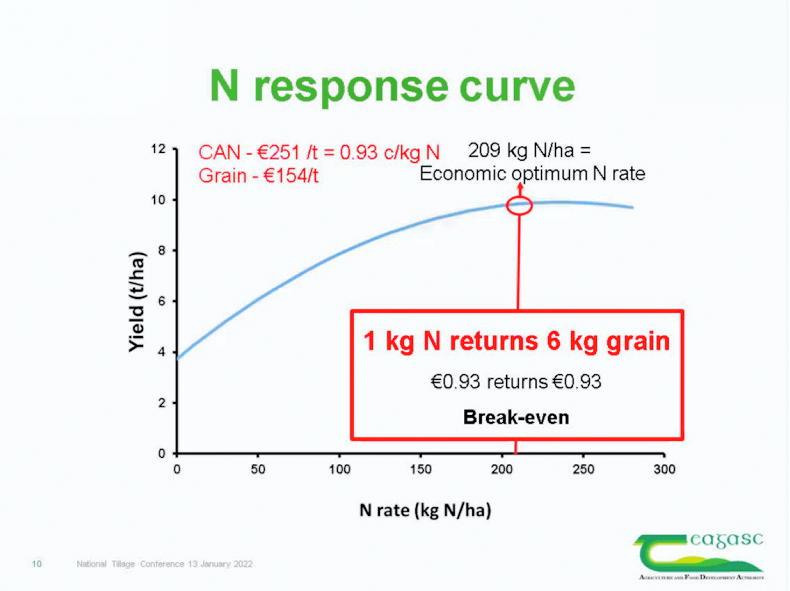
Low N response
From here, the breakeven ratio can be calculated. The breakeven ratio is the required kg of grain required to pay for 1kg N. In this case, the figure is 6kg. This can be calculated as follows:
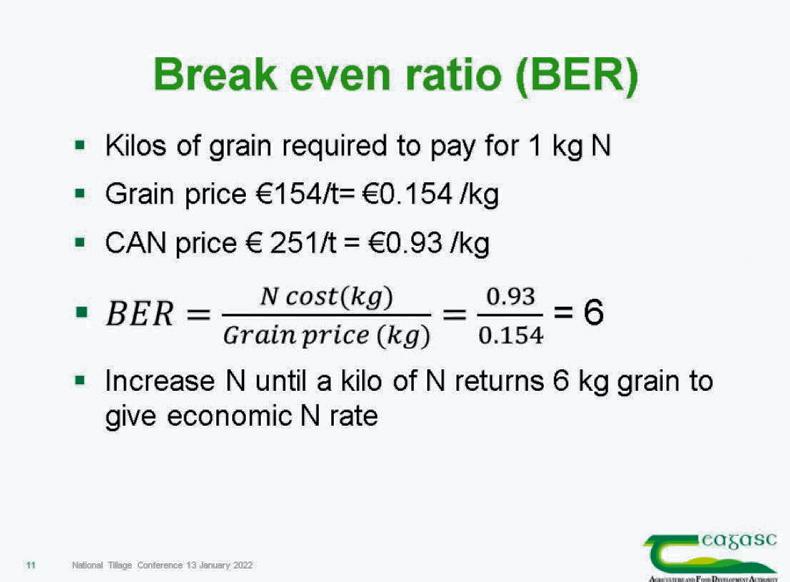
Break even ratio
Today’s prices
The same principle applies when based on today’s prices. At today’s grain and N prices (€220/t for grain and €675/t for CAN), this equates to a breakeven ratio of 11.4.
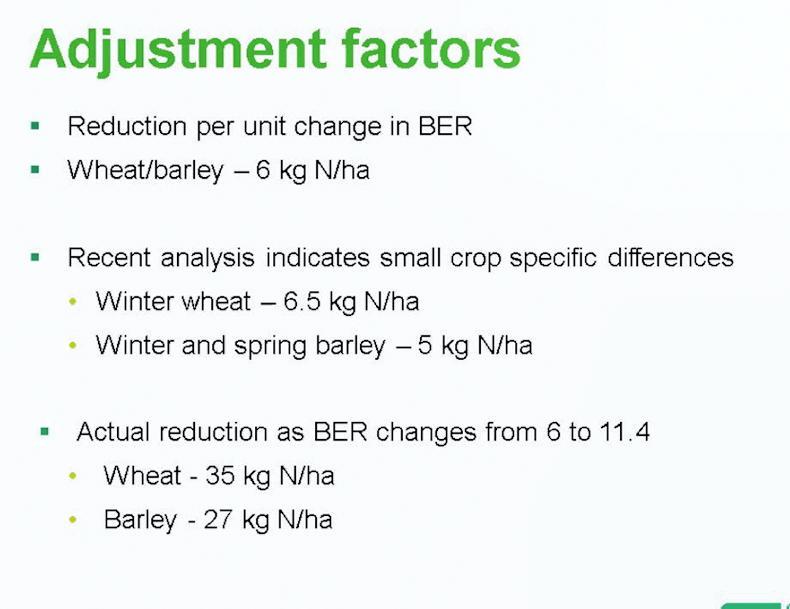
Adjusted to today's prices
When adjusted, this equates to an N reduction of 35kg N/ha for wheat and 27 kg N/ha for barley in order to reach the BER of 11.4.
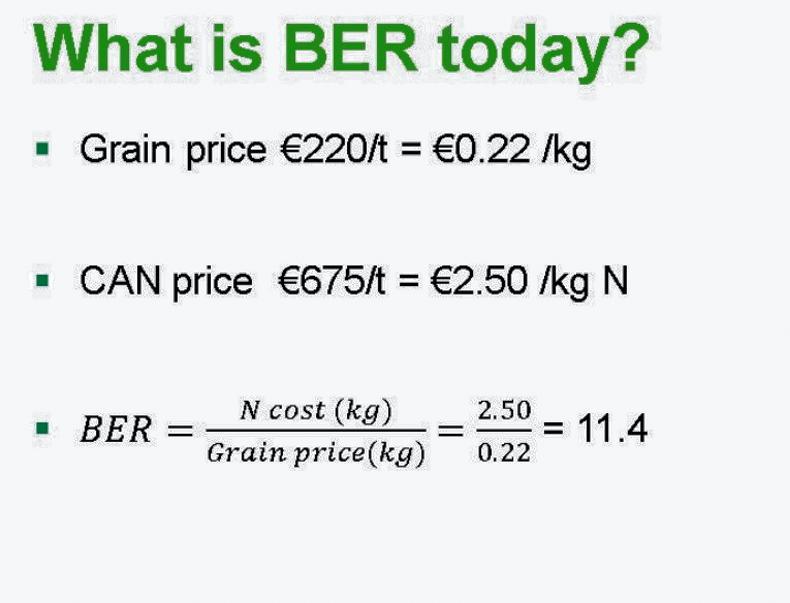
Today's BER
The question then turns to what impact this reduction will have on yield. According to Richie, a reduction of 25kg/ha will result in a yield loss of between 0.2t and 0.3t/ha for winter and spring barley and winter wheat.
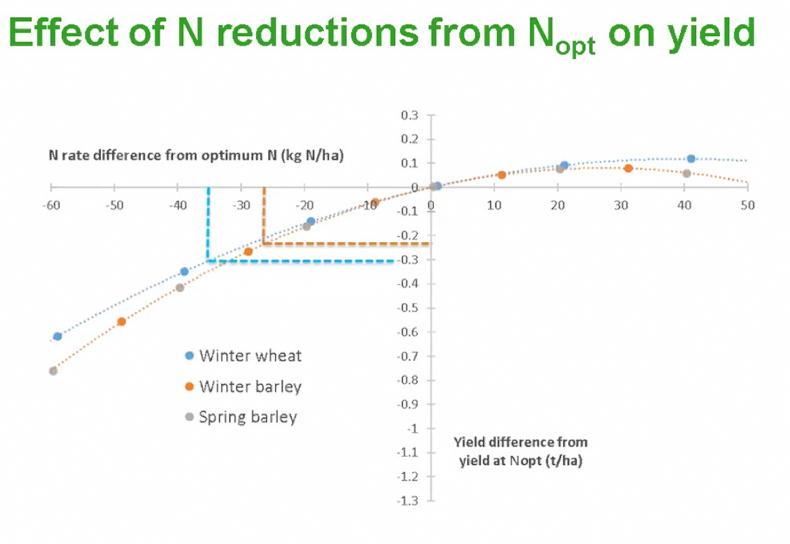
Effect on yield
Richie stressed that the exception to this is for malting barley crops where N rates are already significantly reduced. Growers should show caution when reducing N rates further on malting crops.
How will this affect margins?
When looking at the effects of N cost and grain price over margin, the results are better than one might expect.
Richie explains that as long as grain prices hold up (based on €220/t), an average rate of 190kg N/ha will still deliver an acceptable margin as long as anticipated yields are achieved.
The great challenge in this is that we have little guarantee that grain prices will hold up until later in the year.

Margins
He says that, considering the anticipated reduction in growers' N application rates, fertiliser should be applied as close to when the crop needs it as possible. This is in order to maximise efficiency.
In the case of winter crops, this is primarily in the stem extension stage.
If applying more than 150kg N/ha, he recommended sticking to a three-split application strategy, but remember to equalise the percentage reduction in rates across all splits.
Understanding plants' responses to nitrogen and determining an economical application rate will be vital in growers' fertiliser strategies this year, according to Teagasc’s Dr Richie Hackett.
As fertiliser prices remain at eye-wateringly high levels, the first session of this year’s online National Tillage Conference focused on crop nutrition strategies.
Richie explained that a plant's response to nitrogen (N) is not a straight line, but instead is a curve.
He said that the first 50% of an N application typically gives 70% of the crop yield. The higher up in the curve you go, this response decreases and gives you a lower return from applying N.
Example
For example, based on typical prices over the past few years of grain (€154/t) and CAN (€250/t), 1kg N/ha would return around 30kg of grain on the lower end of the curve.
However, as N application rates increase and we move up the response curve, this return decreases until it reaches the point where no additional grain is returned from spreading additional nitrogen.
Based on the above prices, a breakeven N rate of 209kg N/ha is calculated.

High N response

Low N response
From here, the breakeven ratio can be calculated. The breakeven ratio is the required kg of grain required to pay for 1kg N. In this case, the figure is 6kg. This can be calculated as follows:

Break even ratio
Today’s prices
The same principle applies when based on today’s prices. At today’s grain and N prices (€220/t for grain and €675/t for CAN), this equates to a breakeven ratio of 11.4.

Adjusted to today's prices
When adjusted, this equates to an N reduction of 35kg N/ha for wheat and 27 kg N/ha for barley in order to reach the BER of 11.4.

Today's BER
The question then turns to what impact this reduction will have on yield. According to Richie, a reduction of 25kg/ha will result in a yield loss of between 0.2t and 0.3t/ha for winter and spring barley and winter wheat.

Effect on yield
Richie stressed that the exception to this is for malting barley crops where N rates are already significantly reduced. Growers should show caution when reducing N rates further on malting crops.
How will this affect margins?
When looking at the effects of N cost and grain price over margin, the results are better than one might expect.
Richie explains that as long as grain prices hold up (based on €220/t), an average rate of 190kg N/ha will still deliver an acceptable margin as long as anticipated yields are achieved.
The great challenge in this is that we have little guarantee that grain prices will hold up until later in the year.

Margins
He says that, considering the anticipated reduction in growers' N application rates, fertiliser should be applied as close to when the crop needs it as possible. This is in order to maximise efficiency.
In the case of winter crops, this is primarily in the stem extension stage.
If applying more than 150kg N/ha, he recommended sticking to a three-split application strategy, but remember to equalise the percentage reduction in rates across all splits.













 This is a subscriber-only article
This is a subscriber-only article










SHARING OPTIONS: